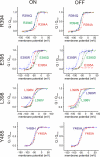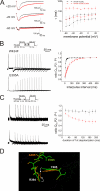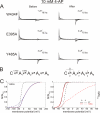An intersubunit interaction between S4-S5 linker and S6 is responsible for the slow off-gating component in Shaker K+ channels
- PMID: 20202932
- PMCID: PMC2859562
- DOI: 10.1074/jbc.M109.097717
An intersubunit interaction between S4-S5 linker and S6 is responsible for the slow off-gating component in Shaker K+ channels
Abstract
Voltage-gated ion channels are controlled by the membrane potential, which is sensed by peripheral, positively charged voltage sensors. The movement of the charged residues in the voltage sensor may be detected as gating currents. In Shaker K(+) channels, the gating currents are asymmetric; although the on-gating currents are fast, the off-gating currents contain a slow component. This slow component is caused by a stabilization of the activated state of the voltage sensor and has been suggested to be linked to ion permeation or C-type inactivation. The molecular determinants responsible for the stabilization, however, remain unknown. Here, we identified an interaction between Arg-394, Glu-395, and Leu-398 on the C termini of the S4-S5 linker and Tyr-485 on the S6 of the neighboring subunit, which is responsible for the development of the slow off-gating component. Mutation of residues involved in this intersubunit interaction modulated the strength of the associated interaction. Impairment of the interaction still led to pore opening but did not exhibit slow gating kinetics. Development of this interaction occurs under physiological ion conduction and is correlated with pore opening. We, thus, suggest that the above residues stabilize the channel in the open state.
Figures









Similar articles
-
Mode shift of the voltage sensors in Shaker K+ channels is caused by energetic coupling to the pore domain.J Gen Physiol. 2011 May;137(5):455-72. doi: 10.1085/jgp.201010573. J Gen Physiol. 2011. PMID: 21518834 Free PMC article.
-
Determinants of voltage-dependent gating and open-state stability in the S5 segment of Shaker potassium channels.J Gen Physiol. 1999 Aug;114(2):215-42. doi: 10.1085/jgp.114.2.215. J Gen Physiol. 1999. PMID: 10435999 Free PMC article.
-
Molecular compatibility of the channel gate and the N terminus of S5 segment for voltage-gated channel activity.J Biol Chem. 2005 May 6;280(18):18253-64. doi: 10.1074/jbc.M413389200. Epub 2005 Mar 4. J Biol Chem. 2005. PMID: 15749711
-
Gating of voltage-dependent potassium channels.Prog Biophys Mol Biol. 2001;75(3):165-99. doi: 10.1016/s0079-6107(01)00006-2. Prog Biophys Mol Biol. 2001. PMID: 11376798 Review.
-
Voltage sensor movement in the hERG K+ channel.Novartis Found Symp. 2005;266:46-52; discussion 52-6, 95-9. doi: 10.1002/047002142x.ch5. Novartis Found Symp. 2005. PMID: 16050261 Review.
Cited by
-
Voltage-dependent gating in K channels: experimental results and quantitative models.Pflugers Arch. 2020 Jan;472(1):27-47. doi: 10.1007/s00424-019-02336-6. Epub 2019 Dec 20. Pflugers Arch. 2020. PMID: 31863286 Review.
-
Stabilization of the Activated hERG Channel Voltage Sensor by Depolarization Involves the S4-S5 Linker.Biophys J. 2017 Jan 24;112(2):300-312. doi: 10.1016/j.bpj.2016.12.021. Biophys J. 2017. PMID: 28122216 Free PMC article.
-
Perspectives on: conformational coupling in ion channels: thermodynamics of electromechanical coupling in voltage-gated ion channels.J Gen Physiol. 2012 Dec;140(6):613-23. doi: 10.1085/jgp.201210840. J Gen Physiol. 2012. PMID: 23183697 Free PMC article. No abstract available.
-
The S4-S5 linker of KCNQ1 channels forms a structural scaffold with the S6 segment controlling gate closure.J Biol Chem. 2011 Jan 7;286(1):717-25. doi: 10.1074/jbc.M110.146977. Epub 2010 Nov 8. J Biol Chem. 2011. PMID: 21059661 Free PMC article.
-
Gating interaction maps reveal a noncanonical electromechanical coupling mode in the Shaker K+ channel.Nat Struct Mol Biol. 2018 Apr;25(4):320-326. doi: 10.1038/s41594-018-0047-3. Epub 2018 Mar 26. Nat Struct Mol Biol. 2018. PMID: 29581567 Free PMC article.
References
Publication types
MeSH terms
Substances
Grants and funding
LinkOut - more resources
Full Text Sources
Other Literature Sources

